Challenges of a Smart City and Its Solutions: A Report
VerifiedAdded on 2022/08/14
|15
|4569
|17
Report
AI Summary
This report delves into the multifaceted challenges confronting smart cities, particularly focusing on the United Kingdom's context. It explores the technological advancements that define smart cities, such as the Internet of Things (IoT) and Big Data, while also addressing their limitations, including cybersecurity threats and susceptibility to disasters. The report examines specific issues like road congestion, data leakage, software vulnerabilities, and the over-reliance on smart technologies. Furthermore, it analyzes the infrastructural limitations within smart buildings, including the need for consistent system functionality and robust cybersecurity measures, and the importance of addressing health and safety concerns. The report concludes by proposing potential solutions to mitigate these challenges, aiming to foster sustainable urban development and enhance the quality of life for residents. The report is a comprehensive analysis of the challenges and solutions associated with smart cities, covering cybersecurity, traffic management, and data privacy, and the importance of addressing health and safety concerns.
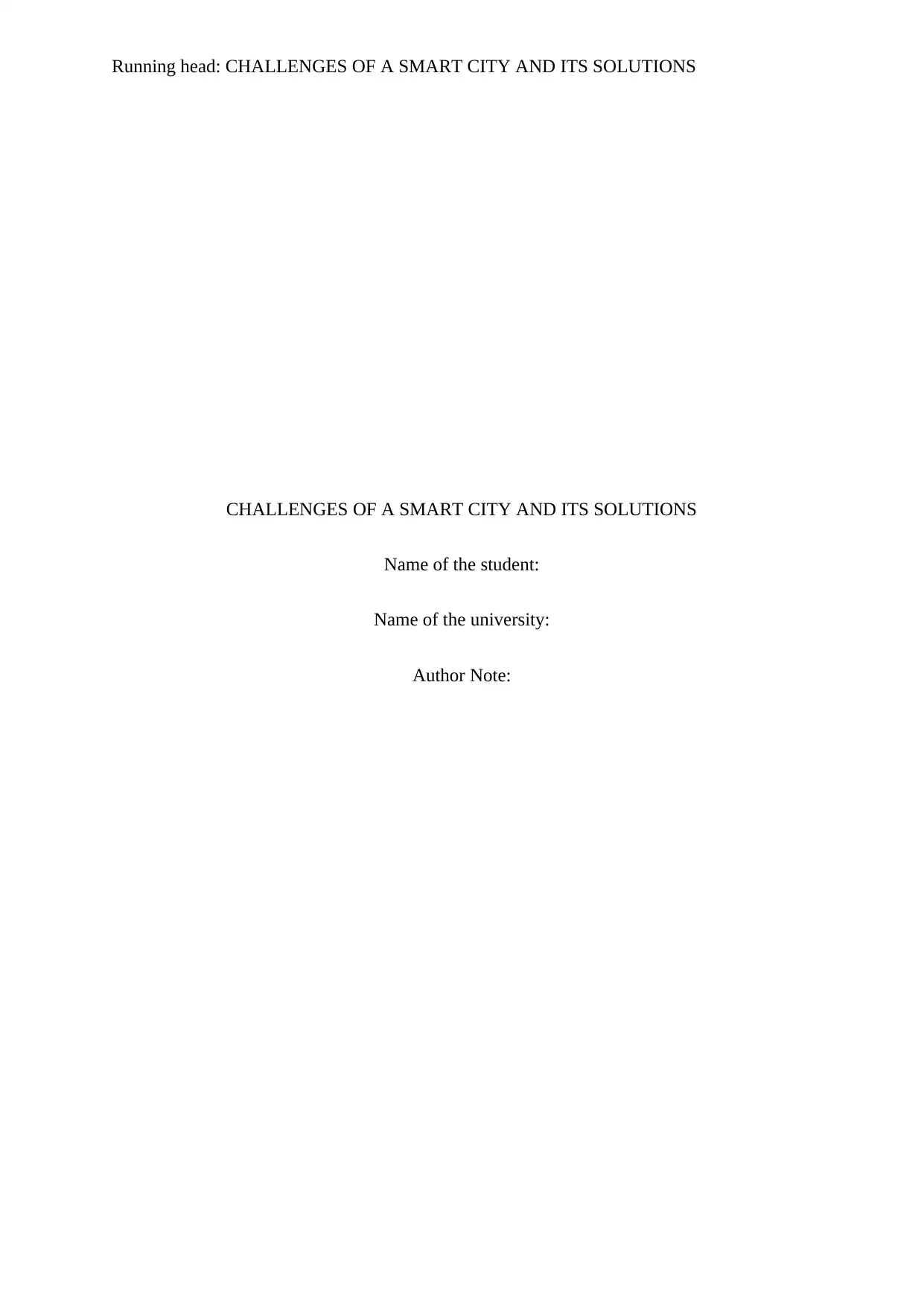
Running head: CHALLENGES OF A SMART CITY AND ITS SOLUTIONS
CHALLENGES OF A SMART CITY AND ITS SOLUTIONS
Name of the student:
Name of the university:
Author Note:
CHALLENGES OF A SMART CITY AND ITS SOLUTIONS
Name of the student:
Name of the university:
Author Note:
Paraphrase This Document
Need a fresh take? Get an instant paraphrase of this document with our AI Paraphraser

1CHALLENGES OF A SMART CITY AND ITS SOLUTIONS
Table of Contents
Introduction................................................................................................................................2
Literature Review.......................................................................................................................3
Limitations.................................................................................................................................6
Solution......................................................................................................................................9
Conclusion................................................................................................................................11
References................................................................................................................................12
Table of Contents
Introduction................................................................................................................................2
Literature Review.......................................................................................................................3
Limitations.................................................................................................................................6
Solution......................................................................................................................................9
Conclusion................................................................................................................................11
References................................................................................................................................12
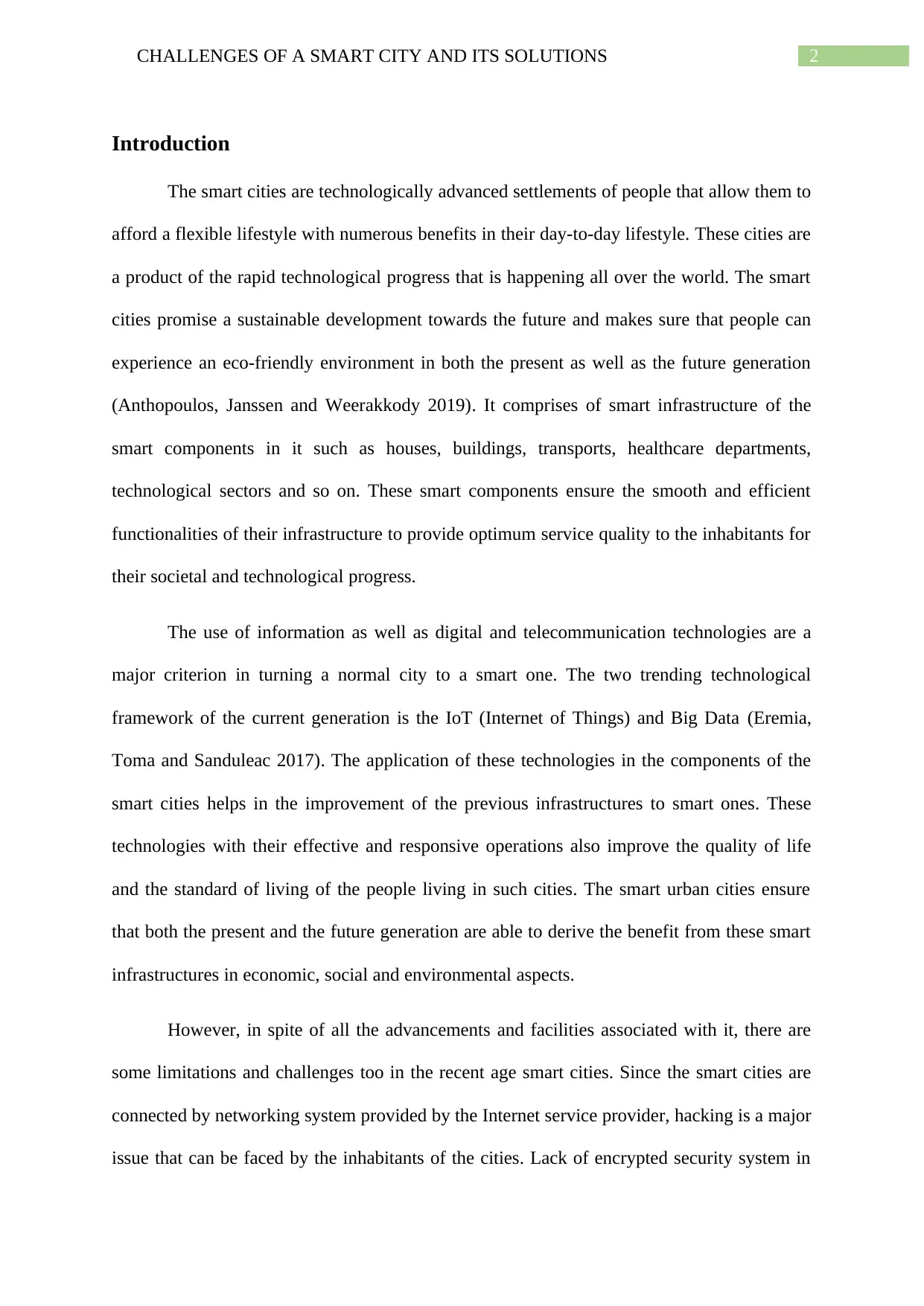
2CHALLENGES OF A SMART CITY AND ITS SOLUTIONS
Introduction
The smart cities are technologically advanced settlements of people that allow them to
afford a flexible lifestyle with numerous benefits in their day-to-day lifestyle. These cities are
a product of the rapid technological progress that is happening all over the world. The smart
cities promise a sustainable development towards the future and makes sure that people can
experience an eco-friendly environment in both the present as well as the future generation
(Anthopoulos, Janssen and Weerakkody 2019). It comprises of smart infrastructure of the
smart components in it such as houses, buildings, transports, healthcare departments,
technological sectors and so on. These smart components ensure the smooth and efficient
functionalities of their infrastructure to provide optimum service quality to the inhabitants for
their societal and technological progress.
The use of information as well as digital and telecommunication technologies are a
major criterion in turning a normal city to a smart one. The two trending technological
framework of the current generation is the IoT (Internet of Things) and Big Data (Eremia,
Toma and Sanduleac 2017). The application of these technologies in the components of the
smart cities helps in the improvement of the previous infrastructures to smart ones. These
technologies with their effective and responsive operations also improve the quality of life
and the standard of living of the people living in such cities. The smart urban cities ensure
that both the present and the future generation are able to derive the benefit from these smart
infrastructures in economic, social and environmental aspects.
However, in spite of all the advancements and facilities associated with it, there are
some limitations and challenges too in the recent age smart cities. Since the smart cities are
connected by networking system provided by the Internet service provider, hacking is a major
issue that can be faced by the inhabitants of the cities. Lack of encrypted security system in
Introduction
The smart cities are technologically advanced settlements of people that allow them to
afford a flexible lifestyle with numerous benefits in their day-to-day lifestyle. These cities are
a product of the rapid technological progress that is happening all over the world. The smart
cities promise a sustainable development towards the future and makes sure that people can
experience an eco-friendly environment in both the present as well as the future generation
(Anthopoulos, Janssen and Weerakkody 2019). It comprises of smart infrastructure of the
smart components in it such as houses, buildings, transports, healthcare departments,
technological sectors and so on. These smart components ensure the smooth and efficient
functionalities of their infrastructure to provide optimum service quality to the inhabitants for
their societal and technological progress.
The use of information as well as digital and telecommunication technologies are a
major criterion in turning a normal city to a smart one. The two trending technological
framework of the current generation is the IoT (Internet of Things) and Big Data (Eremia,
Toma and Sanduleac 2017). The application of these technologies in the components of the
smart cities helps in the improvement of the previous infrastructures to smart ones. These
technologies with their effective and responsive operations also improve the quality of life
and the standard of living of the people living in such cities. The smart urban cities ensure
that both the present and the future generation are able to derive the benefit from these smart
infrastructures in economic, social and environmental aspects.
However, in spite of all the advancements and facilities associated with it, there are
some limitations and challenges too in the recent age smart cities. Since the smart cities are
connected by networking system provided by the Internet service provider, hacking is a major
issue that can be faced by the inhabitants of the cities. Lack of encrypted security system in
⊘ This is a preview!⊘
Do you want full access?
Subscribe today to unlock all pages.

Trusted by 1+ million students worldwide
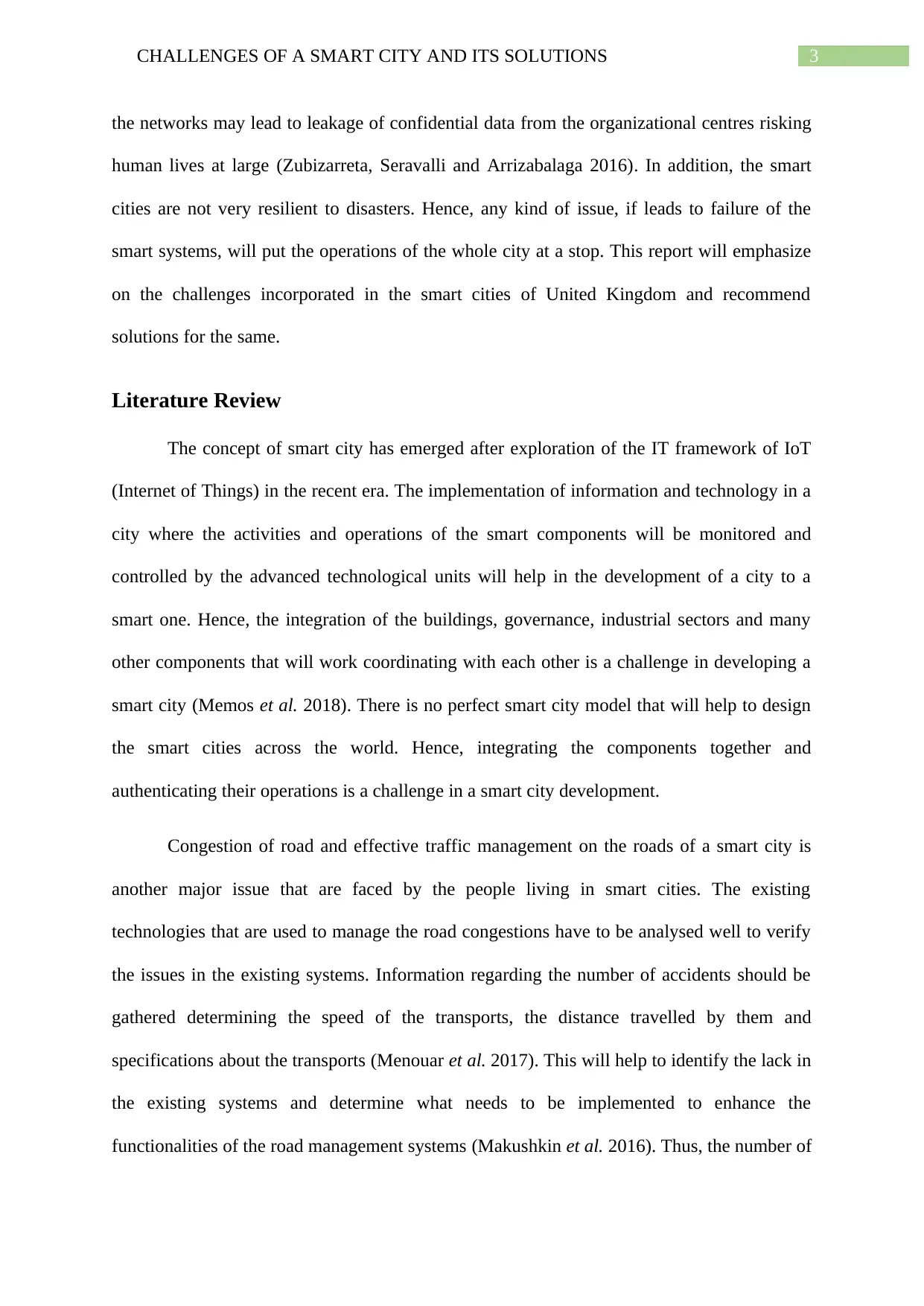
3CHALLENGES OF A SMART CITY AND ITS SOLUTIONS
the networks may lead to leakage of confidential data from the organizational centres risking
human lives at large (Zubizarreta, Seravalli and Arrizabalaga 2016). In addition, the smart
cities are not very resilient to disasters. Hence, any kind of issue, if leads to failure of the
smart systems, will put the operations of the whole city at a stop. This report will emphasize
on the challenges incorporated in the smart cities of United Kingdom and recommend
solutions for the same.
Literature Review
The concept of smart city has emerged after exploration of the IT framework of IoT
(Internet of Things) in the recent era. The implementation of information and technology in a
city where the activities and operations of the smart components will be monitored and
controlled by the advanced technological units will help in the development of a city to a
smart one. Hence, the integration of the buildings, governance, industrial sectors and many
other components that will work coordinating with each other is a challenge in developing a
smart city (Memos et al. 2018). There is no perfect smart city model that will help to design
the smart cities across the world. Hence, integrating the components together and
authenticating their operations is a challenge in a smart city development.
Congestion of road and effective traffic management on the roads of a smart city is
another major issue that are faced by the people living in smart cities. The existing
technologies that are used to manage the road congestions have to be analysed well to verify
the issues in the existing systems. Information regarding the number of accidents should be
gathered determining the speed of the transports, the distance travelled by them and
specifications about the transports (Menouar et al. 2017). This will help to identify the lack in
the existing systems and determine what needs to be implemented to enhance the
functionalities of the road management systems (Makushkin et al. 2016). Thus, the number of
the networks may lead to leakage of confidential data from the organizational centres risking
human lives at large (Zubizarreta, Seravalli and Arrizabalaga 2016). In addition, the smart
cities are not very resilient to disasters. Hence, any kind of issue, if leads to failure of the
smart systems, will put the operations of the whole city at a stop. This report will emphasize
on the challenges incorporated in the smart cities of United Kingdom and recommend
solutions for the same.
Literature Review
The concept of smart city has emerged after exploration of the IT framework of IoT
(Internet of Things) in the recent era. The implementation of information and technology in a
city where the activities and operations of the smart components will be monitored and
controlled by the advanced technological units will help in the development of a city to a
smart one. Hence, the integration of the buildings, governance, industrial sectors and many
other components that will work coordinating with each other is a challenge in developing a
smart city (Memos et al. 2018). There is no perfect smart city model that will help to design
the smart cities across the world. Hence, integrating the components together and
authenticating their operations is a challenge in a smart city development.
Congestion of road and effective traffic management on the roads of a smart city is
another major issue that are faced by the people living in smart cities. The existing
technologies that are used to manage the road congestions have to be analysed well to verify
the issues in the existing systems. Information regarding the number of accidents should be
gathered determining the speed of the transports, the distance travelled by them and
specifications about the transports (Menouar et al. 2017). This will help to identify the lack in
the existing systems and determine what needs to be implemented to enhance the
functionalities of the road management systems (Makushkin et al. 2016). Thus, the number of
Paraphrase This Document
Need a fresh take? Get an instant paraphrase of this document with our AI Paraphraser
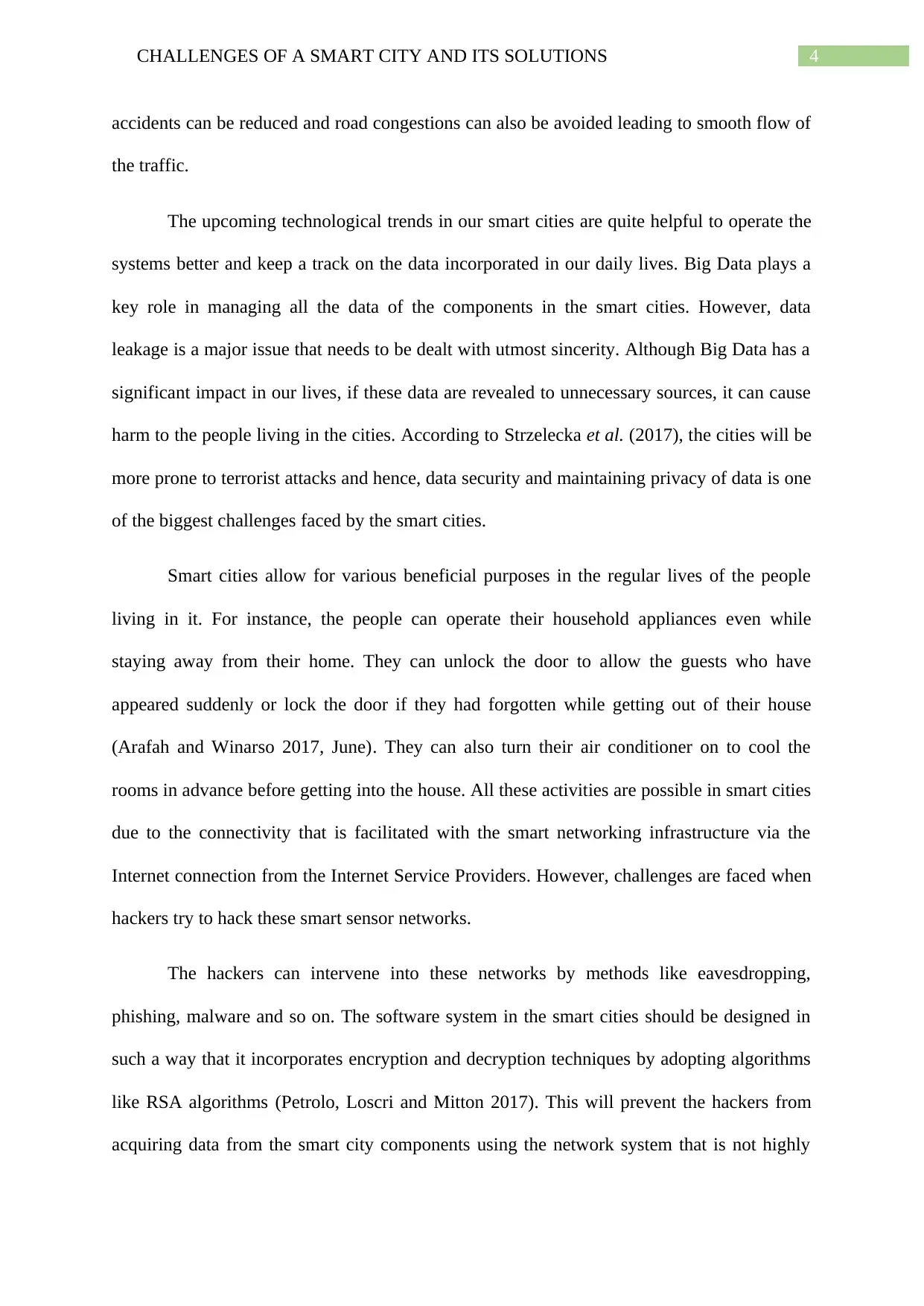
4CHALLENGES OF A SMART CITY AND ITS SOLUTIONS
accidents can be reduced and road congestions can also be avoided leading to smooth flow of
the traffic.
The upcoming technological trends in our smart cities are quite helpful to operate the
systems better and keep a track on the data incorporated in our daily lives. Big Data plays a
key role in managing all the data of the components in the smart cities. However, data
leakage is a major issue that needs to be dealt with utmost sincerity. Although Big Data has a
significant impact in our lives, if these data are revealed to unnecessary sources, it can cause
harm to the people living in the cities. According to Strzelecka et al. (2017), the cities will be
more prone to terrorist attacks and hence, data security and maintaining privacy of data is one
of the biggest challenges faced by the smart cities.
Smart cities allow for various beneficial purposes in the regular lives of the people
living in it. For instance, the people can operate their household appliances even while
staying away from their home. They can unlock the door to allow the guests who have
appeared suddenly or lock the door if they had forgotten while getting out of their house
(Arafah and Winarso 2017, June). They can also turn their air conditioner on to cool the
rooms in advance before getting into the house. All these activities are possible in smart cities
due to the connectivity that is facilitated with the smart networking infrastructure via the
Internet connection from the Internet Service Providers. However, challenges are faced when
hackers try to hack these smart sensor networks.
The hackers can intervene into these networks by methods like eavesdropping,
phishing, malware and so on. The software system in the smart cities should be designed in
such a way that it incorporates encryption and decryption techniques by adopting algorithms
like RSA algorithms (Petrolo, Loscri and Mitton 2017). This will prevent the hackers from
acquiring data from the smart city components using the network system that is not highly
accidents can be reduced and road congestions can also be avoided leading to smooth flow of
the traffic.
The upcoming technological trends in our smart cities are quite helpful to operate the
systems better and keep a track on the data incorporated in our daily lives. Big Data plays a
key role in managing all the data of the components in the smart cities. However, data
leakage is a major issue that needs to be dealt with utmost sincerity. Although Big Data has a
significant impact in our lives, if these data are revealed to unnecessary sources, it can cause
harm to the people living in the cities. According to Strzelecka et al. (2017), the cities will be
more prone to terrorist attacks and hence, data security and maintaining privacy of data is one
of the biggest challenges faced by the smart cities.
Smart cities allow for various beneficial purposes in the regular lives of the people
living in it. For instance, the people can operate their household appliances even while
staying away from their home. They can unlock the door to allow the guests who have
appeared suddenly or lock the door if they had forgotten while getting out of their house
(Arafah and Winarso 2017, June). They can also turn their air conditioner on to cool the
rooms in advance before getting into the house. All these activities are possible in smart cities
due to the connectivity that is facilitated with the smart networking infrastructure via the
Internet connection from the Internet Service Providers. However, challenges are faced when
hackers try to hack these smart sensor networks.
The hackers can intervene into these networks by methods like eavesdropping,
phishing, malware and so on. The software system in the smart cities should be designed in
such a way that it incorporates encryption and decryption techniques by adopting algorithms
like RSA algorithms (Petrolo, Loscri and Mitton 2017). This will prevent the hackers from
acquiring data from the smart city components using the network system that is not highly
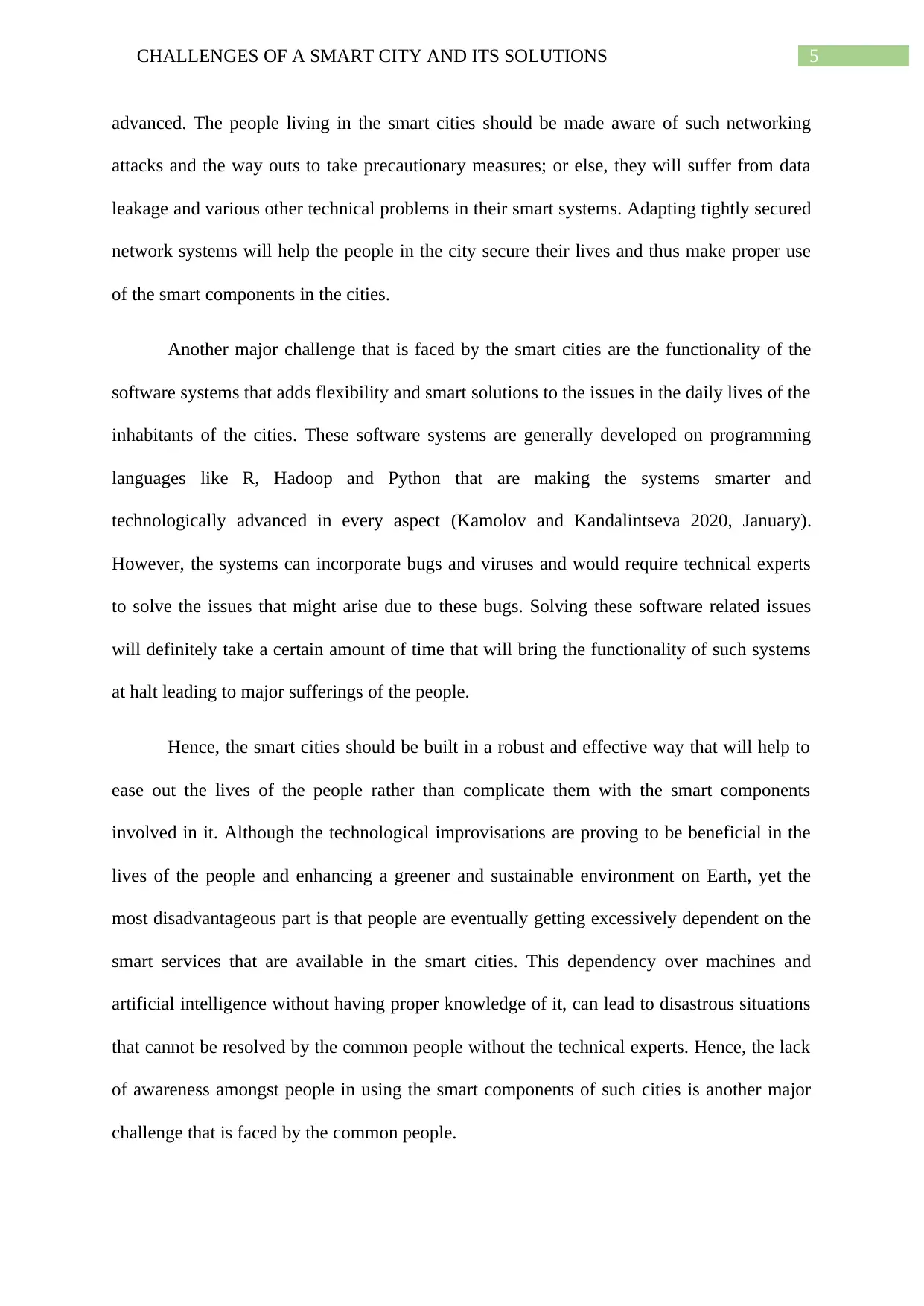
5CHALLENGES OF A SMART CITY AND ITS SOLUTIONS
advanced. The people living in the smart cities should be made aware of such networking
attacks and the way outs to take precautionary measures; or else, they will suffer from data
leakage and various other technical problems in their smart systems. Adapting tightly secured
network systems will help the people in the city secure their lives and thus make proper use
of the smart components in the cities.
Another major challenge that is faced by the smart cities are the functionality of the
software systems that adds flexibility and smart solutions to the issues in the daily lives of the
inhabitants of the cities. These software systems are generally developed on programming
languages like R, Hadoop and Python that are making the systems smarter and
technologically advanced in every aspect (Kamolov and Kandalintseva 2020, January).
However, the systems can incorporate bugs and viruses and would require technical experts
to solve the issues that might arise due to these bugs. Solving these software related issues
will definitely take a certain amount of time that will bring the functionality of such systems
at halt leading to major sufferings of the people.
Hence, the smart cities should be built in a robust and effective way that will help to
ease out the lives of the people rather than complicate them with the smart components
involved in it. Although the technological improvisations are proving to be beneficial in the
lives of the people and enhancing a greener and sustainable environment on Earth, yet the
most disadvantageous part is that people are eventually getting excessively dependent on the
smart services that are available in the smart cities. This dependency over machines and
artificial intelligence without having proper knowledge of it, can lead to disastrous situations
that cannot be resolved by the common people without the technical experts. Hence, the lack
of awareness amongst people in using the smart components of such cities is another major
challenge that is faced by the common people.
advanced. The people living in the smart cities should be made aware of such networking
attacks and the way outs to take precautionary measures; or else, they will suffer from data
leakage and various other technical problems in their smart systems. Adapting tightly secured
network systems will help the people in the city secure their lives and thus make proper use
of the smart components in the cities.
Another major challenge that is faced by the smart cities are the functionality of the
software systems that adds flexibility and smart solutions to the issues in the daily lives of the
inhabitants of the cities. These software systems are generally developed on programming
languages like R, Hadoop and Python that are making the systems smarter and
technologically advanced in every aspect (Kamolov and Kandalintseva 2020, January).
However, the systems can incorporate bugs and viruses and would require technical experts
to solve the issues that might arise due to these bugs. Solving these software related issues
will definitely take a certain amount of time that will bring the functionality of such systems
at halt leading to major sufferings of the people.
Hence, the smart cities should be built in a robust and effective way that will help to
ease out the lives of the people rather than complicate them with the smart components
involved in it. Although the technological improvisations are proving to be beneficial in the
lives of the people and enhancing a greener and sustainable environment on Earth, yet the
most disadvantageous part is that people are eventually getting excessively dependent on the
smart services that are available in the smart cities. This dependency over machines and
artificial intelligence without having proper knowledge of it, can lead to disastrous situations
that cannot be resolved by the common people without the technical experts. Hence, the lack
of awareness amongst people in using the smart components of such cities is another major
challenge that is faced by the common people.
⊘ This is a preview!⊘
Do you want full access?
Subscribe today to unlock all pages.

Trusted by 1+ million students worldwide
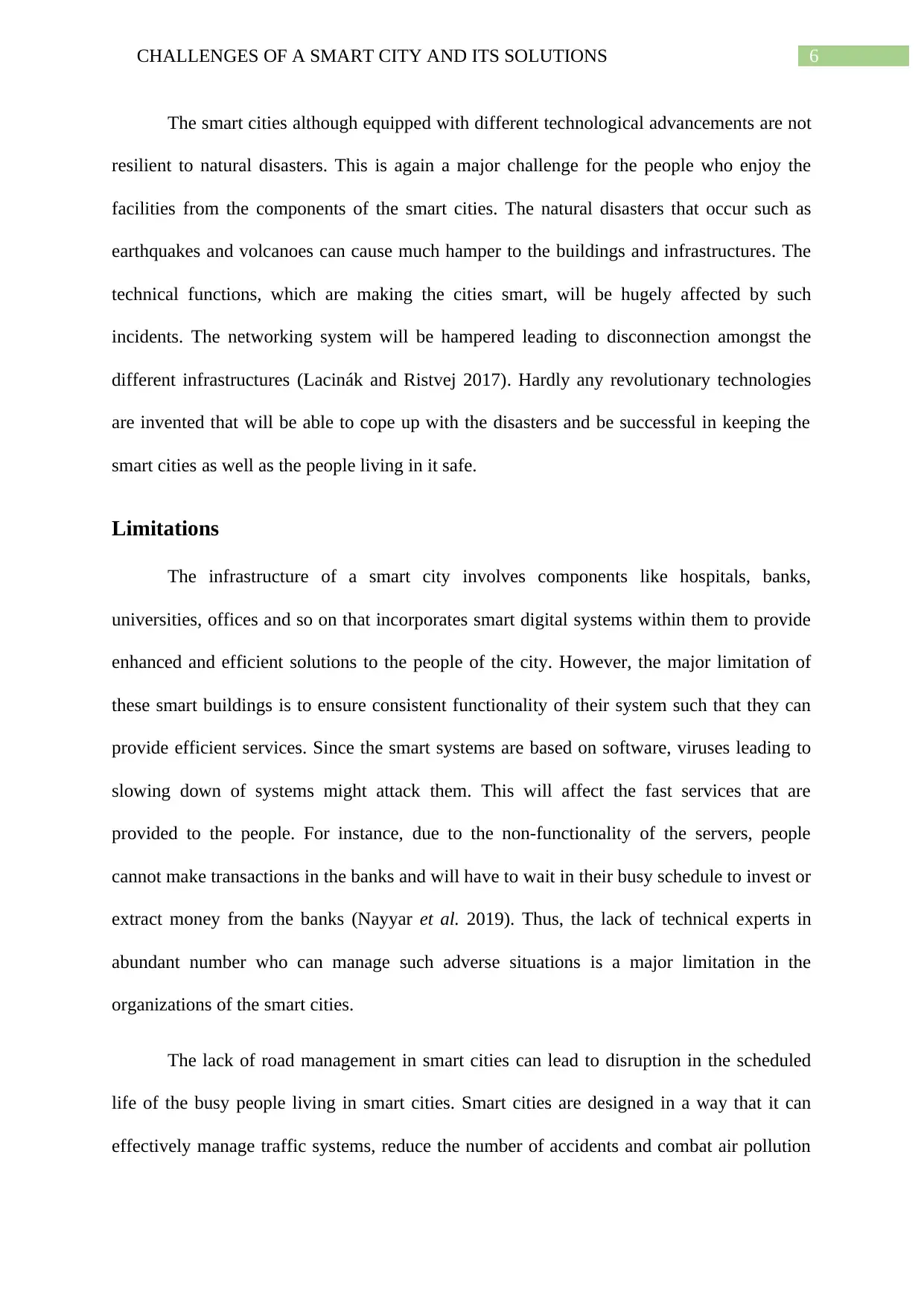
6CHALLENGES OF A SMART CITY AND ITS SOLUTIONS
The smart cities although equipped with different technological advancements are not
resilient to natural disasters. This is again a major challenge for the people who enjoy the
facilities from the components of the smart cities. The natural disasters that occur such as
earthquakes and volcanoes can cause much hamper to the buildings and infrastructures. The
technical functions, which are making the cities smart, will be hugely affected by such
incidents. The networking system will be hampered leading to disconnection amongst the
different infrastructures (Lacinák and Ristvej 2017). Hardly any revolutionary technologies
are invented that will be able to cope up with the disasters and be successful in keeping the
smart cities as well as the people living in it safe.
Limitations
The infrastructure of a smart city involves components like hospitals, banks,
universities, offices and so on that incorporates smart digital systems within them to provide
enhanced and efficient solutions to the people of the city. However, the major limitation of
these smart buildings is to ensure consistent functionality of their system such that they can
provide efficient services. Since the smart systems are based on software, viruses leading to
slowing down of systems might attack them. This will affect the fast services that are
provided to the people. For instance, due to the non-functionality of the servers, people
cannot make transactions in the banks and will have to wait in their busy schedule to invest or
extract money from the banks (Nayyar et al. 2019). Thus, the lack of technical experts in
abundant number who can manage such adverse situations is a major limitation in the
organizations of the smart cities.
The lack of road management in smart cities can lead to disruption in the scheduled
life of the busy people living in smart cities. Smart cities are designed in a way that it can
effectively manage traffic systems, reduce the number of accidents and combat air pollution
The smart cities although equipped with different technological advancements are not
resilient to natural disasters. This is again a major challenge for the people who enjoy the
facilities from the components of the smart cities. The natural disasters that occur such as
earthquakes and volcanoes can cause much hamper to the buildings and infrastructures. The
technical functions, which are making the cities smart, will be hugely affected by such
incidents. The networking system will be hampered leading to disconnection amongst the
different infrastructures (Lacinák and Ristvej 2017). Hardly any revolutionary technologies
are invented that will be able to cope up with the disasters and be successful in keeping the
smart cities as well as the people living in it safe.
Limitations
The infrastructure of a smart city involves components like hospitals, banks,
universities, offices and so on that incorporates smart digital systems within them to provide
enhanced and efficient solutions to the people of the city. However, the major limitation of
these smart buildings is to ensure consistent functionality of their system such that they can
provide efficient services. Since the smart systems are based on software, viruses leading to
slowing down of systems might attack them. This will affect the fast services that are
provided to the people. For instance, due to the non-functionality of the servers, people
cannot make transactions in the banks and will have to wait in their busy schedule to invest or
extract money from the banks (Nayyar et al. 2019). Thus, the lack of technical experts in
abundant number who can manage such adverse situations is a major limitation in the
organizations of the smart cities.
The lack of road management in smart cities can lead to disruption in the scheduled
life of the busy people living in smart cities. Smart cities are designed in a way that it can
effectively manage traffic systems, reduce the number of accidents and combat air pollution
Paraphrase This Document
Need a fresh take? Get an instant paraphrase of this document with our AI Paraphraser
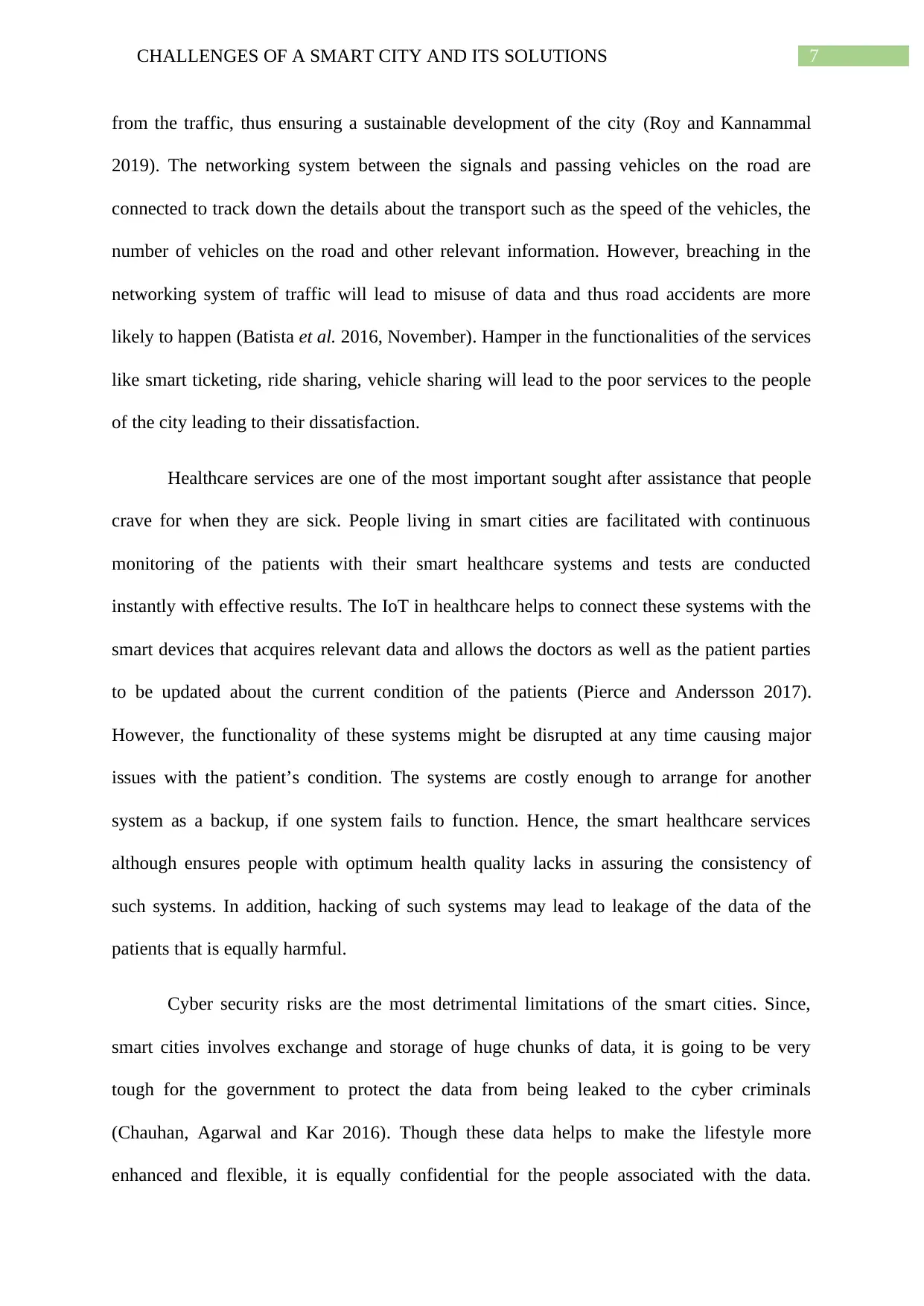
7CHALLENGES OF A SMART CITY AND ITS SOLUTIONS
from the traffic, thus ensuring a sustainable development of the city (Roy and Kannammal
2019). The networking system between the signals and passing vehicles on the road are
connected to track down the details about the transport such as the speed of the vehicles, the
number of vehicles on the road and other relevant information. However, breaching in the
networking system of traffic will lead to misuse of data and thus road accidents are more
likely to happen (Batista et al. 2016, November). Hamper in the functionalities of the services
like smart ticketing, ride sharing, vehicle sharing will lead to the poor services to the people
of the city leading to their dissatisfaction.
Healthcare services are one of the most important sought after assistance that people
crave for when they are sick. People living in smart cities are facilitated with continuous
monitoring of the patients with their smart healthcare systems and tests are conducted
instantly with effective results. The IoT in healthcare helps to connect these systems with the
smart devices that acquires relevant data and allows the doctors as well as the patient parties
to be updated about the current condition of the patients (Pierce and Andersson 2017).
However, the functionality of these systems might be disrupted at any time causing major
issues with the patient’s condition. The systems are costly enough to arrange for another
system as a backup, if one system fails to function. Hence, the smart healthcare services
although ensures people with optimum health quality lacks in assuring the consistency of
such systems. In addition, hacking of such systems may lead to leakage of the data of the
patients that is equally harmful.
Cyber security risks are the most detrimental limitations of the smart cities. Since,
smart cities involves exchange and storage of huge chunks of data, it is going to be very
tough for the government to protect the data from being leaked to the cyber criminals
(Chauhan, Agarwal and Kar 2016). Though these data helps to make the lifestyle more
enhanced and flexible, it is equally confidential for the people associated with the data.
from the traffic, thus ensuring a sustainable development of the city (Roy and Kannammal
2019). The networking system between the signals and passing vehicles on the road are
connected to track down the details about the transport such as the speed of the vehicles, the
number of vehicles on the road and other relevant information. However, breaching in the
networking system of traffic will lead to misuse of data and thus road accidents are more
likely to happen (Batista et al. 2016, November). Hamper in the functionalities of the services
like smart ticketing, ride sharing, vehicle sharing will lead to the poor services to the people
of the city leading to their dissatisfaction.
Healthcare services are one of the most important sought after assistance that people
crave for when they are sick. People living in smart cities are facilitated with continuous
monitoring of the patients with their smart healthcare systems and tests are conducted
instantly with effective results. The IoT in healthcare helps to connect these systems with the
smart devices that acquires relevant data and allows the doctors as well as the patient parties
to be updated about the current condition of the patients (Pierce and Andersson 2017).
However, the functionality of these systems might be disrupted at any time causing major
issues with the patient’s condition. The systems are costly enough to arrange for another
system as a backup, if one system fails to function. Hence, the smart healthcare services
although ensures people with optimum health quality lacks in assuring the consistency of
such systems. In addition, hacking of such systems may lead to leakage of the data of the
patients that is equally harmful.
Cyber security risks are the most detrimental limitations of the smart cities. Since,
smart cities involves exchange and storage of huge chunks of data, it is going to be very
tough for the government to protect the data from being leaked to the cyber criminals
(Chauhan, Agarwal and Kar 2016). Though these data helps to make the lifestyle more
enhanced and flexible, it is equally confidential for the people associated with the data.
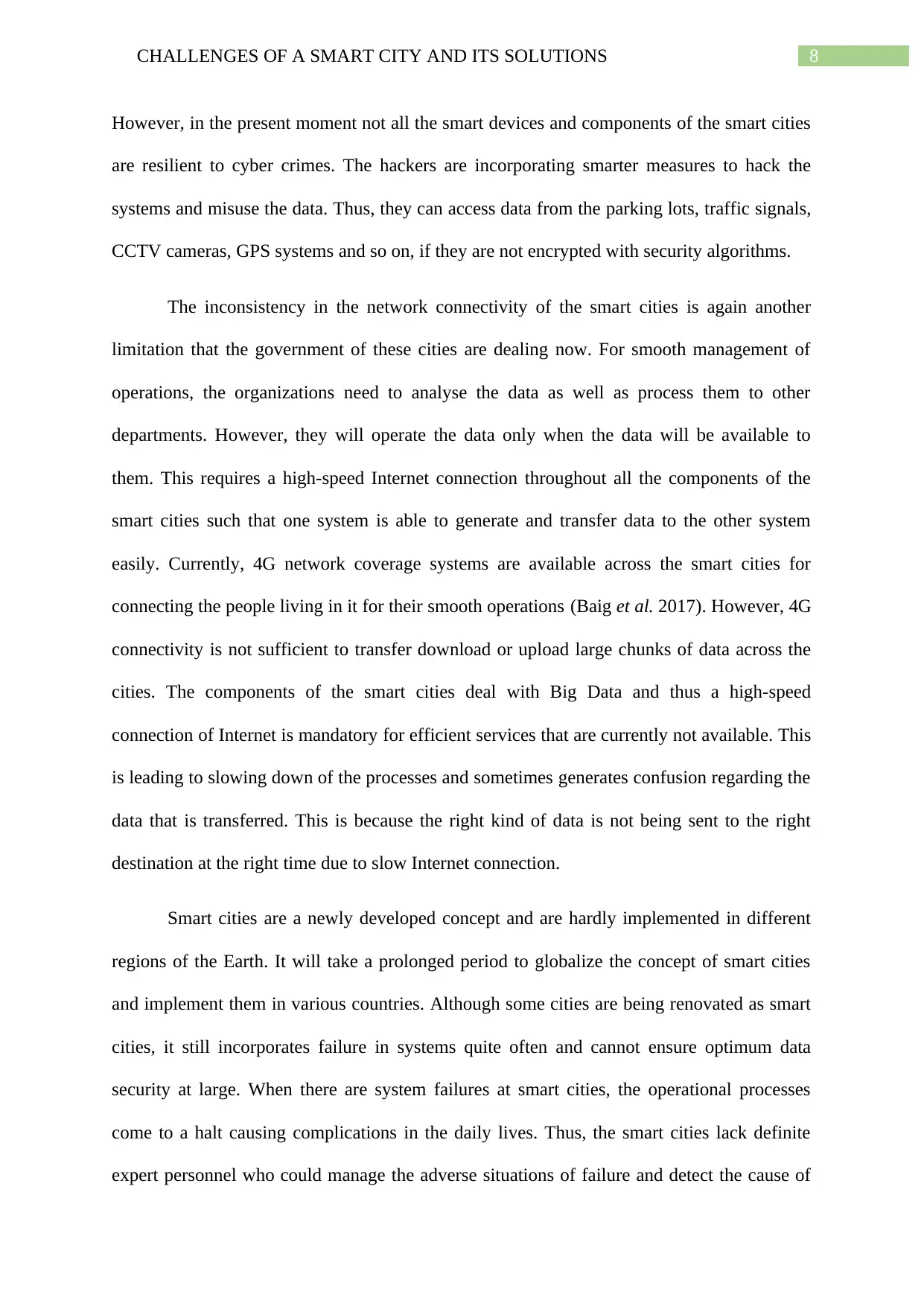
8CHALLENGES OF A SMART CITY AND ITS SOLUTIONS
However, in the present moment not all the smart devices and components of the smart cities
are resilient to cyber crimes. The hackers are incorporating smarter measures to hack the
systems and misuse the data. Thus, they can access data from the parking lots, traffic signals,
CCTV cameras, GPS systems and so on, if they are not encrypted with security algorithms.
The inconsistency in the network connectivity of the smart cities is again another
limitation that the government of these cities are dealing now. For smooth management of
operations, the organizations need to analyse the data as well as process them to other
departments. However, they will operate the data only when the data will be available to
them. This requires a high-speed Internet connection throughout all the components of the
smart cities such that one system is able to generate and transfer data to the other system
easily. Currently, 4G network coverage systems are available across the smart cities for
connecting the people living in it for their smooth operations (Baig et al. 2017). However, 4G
connectivity is not sufficient to transfer download or upload large chunks of data across the
cities. The components of the smart cities deal with Big Data and thus a high-speed
connection of Internet is mandatory for efficient services that are currently not available. This
is leading to slowing down of the processes and sometimes generates confusion regarding the
data that is transferred. This is because the right kind of data is not being sent to the right
destination at the right time due to slow Internet connection.
Smart cities are a newly developed concept and are hardly implemented in different
regions of the Earth. It will take a prolonged period to globalize the concept of smart cities
and implement them in various countries. Although some cities are being renovated as smart
cities, it still incorporates failure in systems quite often and cannot ensure optimum data
security at large. When there are system failures at smart cities, the operational processes
come to a halt causing complications in the daily lives. Thus, the smart cities lack definite
expert personnel who could manage the adverse situations of failure and detect the cause of
However, in the present moment not all the smart devices and components of the smart cities
are resilient to cyber crimes. The hackers are incorporating smarter measures to hack the
systems and misuse the data. Thus, they can access data from the parking lots, traffic signals,
CCTV cameras, GPS systems and so on, if they are not encrypted with security algorithms.
The inconsistency in the network connectivity of the smart cities is again another
limitation that the government of these cities are dealing now. For smooth management of
operations, the organizations need to analyse the data as well as process them to other
departments. However, they will operate the data only when the data will be available to
them. This requires a high-speed Internet connection throughout all the components of the
smart cities such that one system is able to generate and transfer data to the other system
easily. Currently, 4G network coverage systems are available across the smart cities for
connecting the people living in it for their smooth operations (Baig et al. 2017). However, 4G
connectivity is not sufficient to transfer download or upload large chunks of data across the
cities. The components of the smart cities deal with Big Data and thus a high-speed
connection of Internet is mandatory for efficient services that are currently not available. This
is leading to slowing down of the processes and sometimes generates confusion regarding the
data that is transferred. This is because the right kind of data is not being sent to the right
destination at the right time due to slow Internet connection.
Smart cities are a newly developed concept and are hardly implemented in different
regions of the Earth. It will take a prolonged period to globalize the concept of smart cities
and implement them in various countries. Although some cities are being renovated as smart
cities, it still incorporates failure in systems quite often and cannot ensure optimum data
security at large. When there are system failures at smart cities, the operational processes
come to a halt causing complications in the daily lives. Thus, the smart cities lack definite
expert personnel who could manage the adverse situations of failure and detect the cause of
⊘ This is a preview!⊘
Do you want full access?
Subscribe today to unlock all pages.

Trusted by 1+ million students worldwide
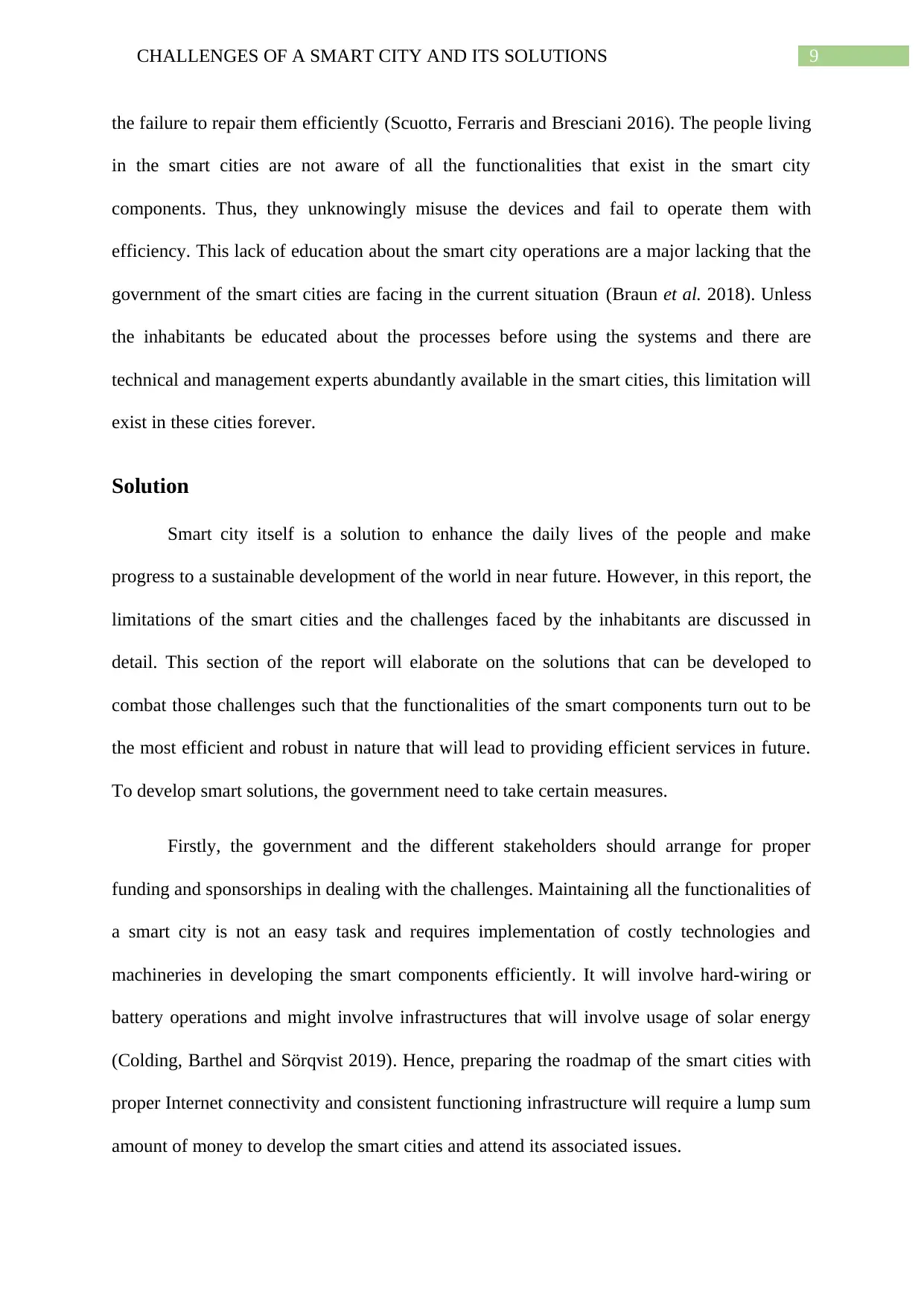
9CHALLENGES OF A SMART CITY AND ITS SOLUTIONS
the failure to repair them efficiently (Scuotto, Ferraris and Bresciani 2016). The people living
in the smart cities are not aware of all the functionalities that exist in the smart city
components. Thus, they unknowingly misuse the devices and fail to operate them with
efficiency. This lack of education about the smart city operations are a major lacking that the
government of the smart cities are facing in the current situation (Braun et al. 2018). Unless
the inhabitants be educated about the processes before using the systems and there are
technical and management experts abundantly available in the smart cities, this limitation will
exist in these cities forever.
Solution
Smart city itself is a solution to enhance the daily lives of the people and make
progress to a sustainable development of the world in near future. However, in this report, the
limitations of the smart cities and the challenges faced by the inhabitants are discussed in
detail. This section of the report will elaborate on the solutions that can be developed to
combat those challenges such that the functionalities of the smart components turn out to be
the most efficient and robust in nature that will lead to providing efficient services in future.
To develop smart solutions, the government need to take certain measures.
Firstly, the government and the different stakeholders should arrange for proper
funding and sponsorships in dealing with the challenges. Maintaining all the functionalities of
a smart city is not an easy task and requires implementation of costly technologies and
machineries in developing the smart components efficiently. It will involve hard-wiring or
battery operations and might involve infrastructures that will involve usage of solar energy
(Colding, Barthel and Sörqvist 2019). Hence, preparing the roadmap of the smart cities with
proper Internet connectivity and consistent functioning infrastructure will require a lump sum
amount of money to develop the smart cities and attend its associated issues.
the failure to repair them efficiently (Scuotto, Ferraris and Bresciani 2016). The people living
in the smart cities are not aware of all the functionalities that exist in the smart city
components. Thus, they unknowingly misuse the devices and fail to operate them with
efficiency. This lack of education about the smart city operations are a major lacking that the
government of the smart cities are facing in the current situation (Braun et al. 2018). Unless
the inhabitants be educated about the processes before using the systems and there are
technical and management experts abundantly available in the smart cities, this limitation will
exist in these cities forever.
Solution
Smart city itself is a solution to enhance the daily lives of the people and make
progress to a sustainable development of the world in near future. However, in this report, the
limitations of the smart cities and the challenges faced by the inhabitants are discussed in
detail. This section of the report will elaborate on the solutions that can be developed to
combat those challenges such that the functionalities of the smart components turn out to be
the most efficient and robust in nature that will lead to providing efficient services in future.
To develop smart solutions, the government need to take certain measures.
Firstly, the government and the different stakeholders should arrange for proper
funding and sponsorships in dealing with the challenges. Maintaining all the functionalities of
a smart city is not an easy task and requires implementation of costly technologies and
machineries in developing the smart components efficiently. It will involve hard-wiring or
battery operations and might involve infrastructures that will involve usage of solar energy
(Colding, Barthel and Sörqvist 2019). Hence, preparing the roadmap of the smart cities with
proper Internet connectivity and consistent functioning infrastructure will require a lump sum
amount of money to develop the smart cities and attend its associated issues.
Paraphrase This Document
Need a fresh take? Get an instant paraphrase of this document with our AI Paraphraser
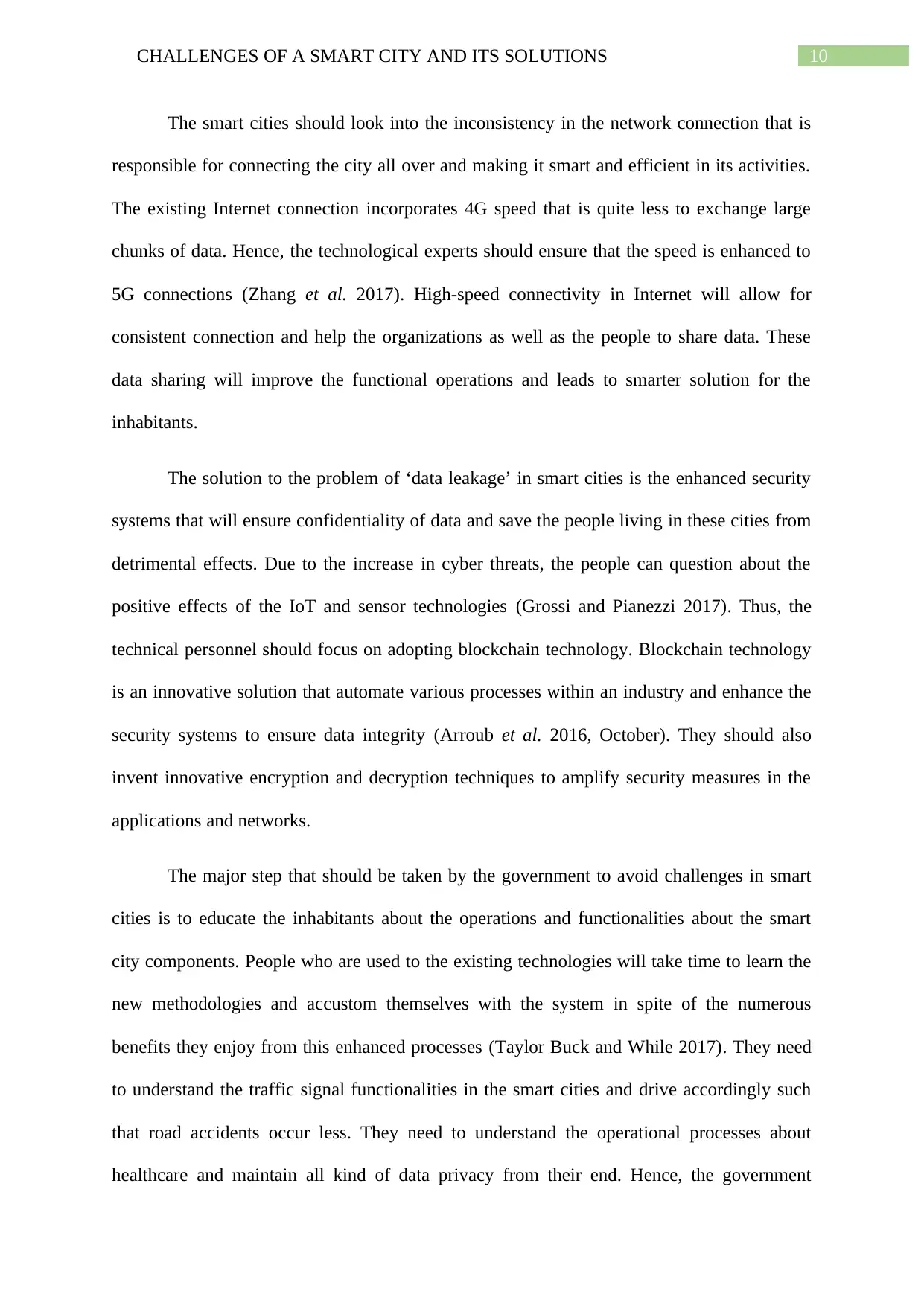
10CHALLENGES OF A SMART CITY AND ITS SOLUTIONS
The smart cities should look into the inconsistency in the network connection that is
responsible for connecting the city all over and making it smart and efficient in its activities.
The existing Internet connection incorporates 4G speed that is quite less to exchange large
chunks of data. Hence, the technological experts should ensure that the speed is enhanced to
5G connections (Zhang et al. 2017). High-speed connectivity in Internet will allow for
consistent connection and help the organizations as well as the people to share data. These
data sharing will improve the functional operations and leads to smarter solution for the
inhabitants.
The solution to the problem of ‘data leakage’ in smart cities is the enhanced security
systems that will ensure confidentiality of data and save the people living in these cities from
detrimental effects. Due to the increase in cyber threats, the people can question about the
positive effects of the IoT and sensor technologies (Grossi and Pianezzi 2017). Thus, the
technical personnel should focus on adopting blockchain technology. Blockchain technology
is an innovative solution that automate various processes within an industry and enhance the
security systems to ensure data integrity (Arroub et al. 2016, October). They should also
invent innovative encryption and decryption techniques to amplify security measures in the
applications and networks.
The major step that should be taken by the government to avoid challenges in smart
cities is to educate the inhabitants about the operations and functionalities about the smart
city components. People who are used to the existing technologies will take time to learn the
new methodologies and accustom themselves with the system in spite of the numerous
benefits they enjoy from this enhanced processes (Taylor Buck and While 2017). They need
to understand the traffic signal functionalities in the smart cities and drive accordingly such
that road accidents occur less. They need to understand the operational processes about
healthcare and maintain all kind of data privacy from their end. Hence, the government
The smart cities should look into the inconsistency in the network connection that is
responsible for connecting the city all over and making it smart and efficient in its activities.
The existing Internet connection incorporates 4G speed that is quite less to exchange large
chunks of data. Hence, the technological experts should ensure that the speed is enhanced to
5G connections (Zhang et al. 2017). High-speed connectivity in Internet will allow for
consistent connection and help the organizations as well as the people to share data. These
data sharing will improve the functional operations and leads to smarter solution for the
inhabitants.
The solution to the problem of ‘data leakage’ in smart cities is the enhanced security
systems that will ensure confidentiality of data and save the people living in these cities from
detrimental effects. Due to the increase in cyber threats, the people can question about the
positive effects of the IoT and sensor technologies (Grossi and Pianezzi 2017). Thus, the
technical personnel should focus on adopting blockchain technology. Blockchain technology
is an innovative solution that automate various processes within an industry and enhance the
security systems to ensure data integrity (Arroub et al. 2016, October). They should also
invent innovative encryption and decryption techniques to amplify security measures in the
applications and networks.
The major step that should be taken by the government to avoid challenges in smart
cities is to educate the inhabitants about the operations and functionalities about the smart
city components. People who are used to the existing technologies will take time to learn the
new methodologies and accustom themselves with the system in spite of the numerous
benefits they enjoy from this enhanced processes (Taylor Buck and While 2017). They need
to understand the traffic signal functionalities in the smart cities and drive accordingly such
that road accidents occur less. They need to understand the operational processes about
healthcare and maintain all kind of data privacy from their end. Hence, the government
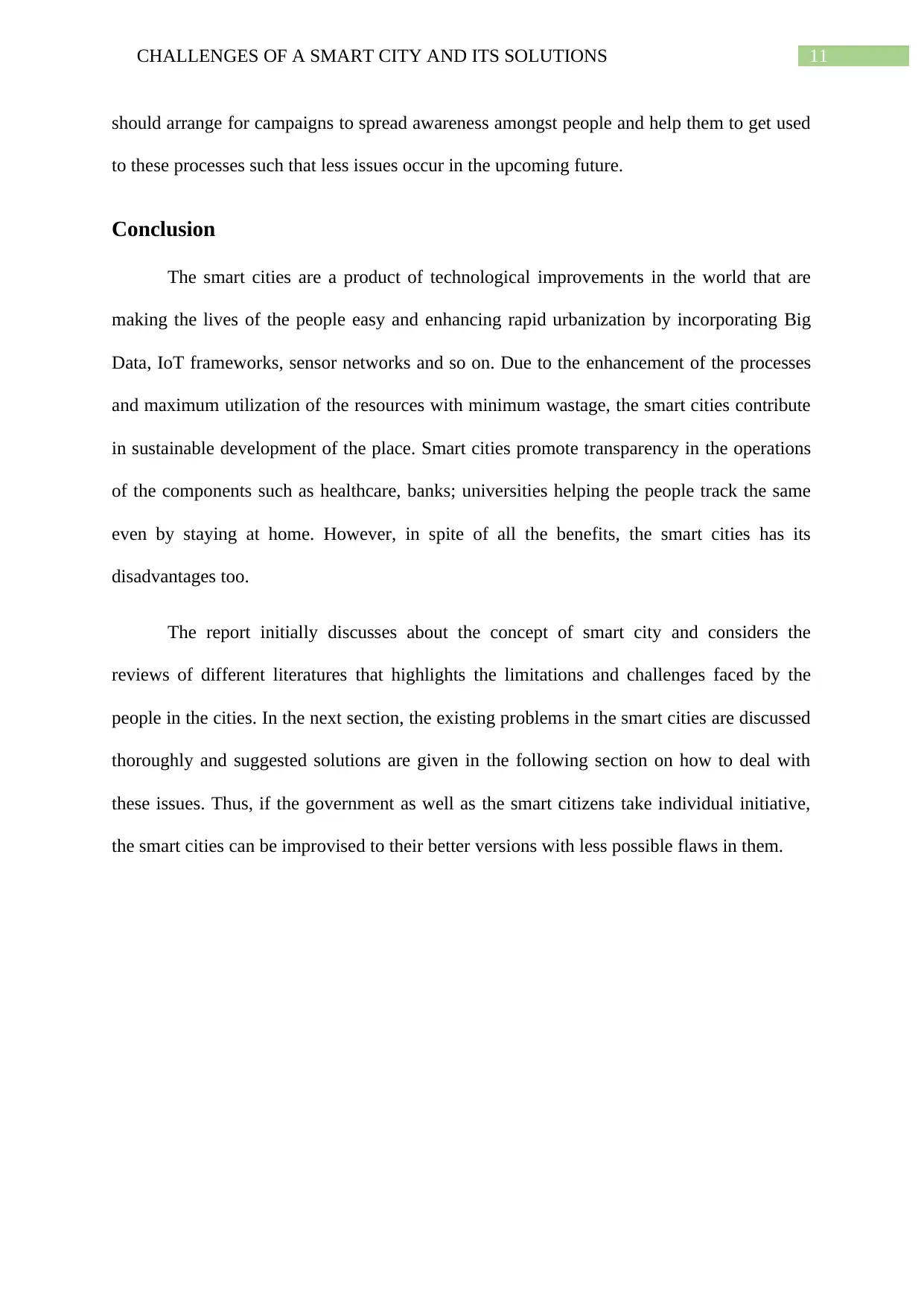
11CHALLENGES OF A SMART CITY AND ITS SOLUTIONS
should arrange for campaigns to spread awareness amongst people and help them to get used
to these processes such that less issues occur in the upcoming future.
Conclusion
The smart cities are a product of technological improvements in the world that are
making the lives of the people easy and enhancing rapid urbanization by incorporating Big
Data, IoT frameworks, sensor networks and so on. Due to the enhancement of the processes
and maximum utilization of the resources with minimum wastage, the smart cities contribute
in sustainable development of the place. Smart cities promote transparency in the operations
of the components such as healthcare, banks; universities helping the people track the same
even by staying at home. However, in spite of all the benefits, the smart cities has its
disadvantages too.
The report initially discusses about the concept of smart city and considers the
reviews of different literatures that highlights the limitations and challenges faced by the
people in the cities. In the next section, the existing problems in the smart cities are discussed
thoroughly and suggested solutions are given in the following section on how to deal with
these issues. Thus, if the government as well as the smart citizens take individual initiative,
the smart cities can be improvised to their better versions with less possible flaws in them.
should arrange for campaigns to spread awareness amongst people and help them to get used
to these processes such that less issues occur in the upcoming future.
Conclusion
The smart cities are a product of technological improvements in the world that are
making the lives of the people easy and enhancing rapid urbanization by incorporating Big
Data, IoT frameworks, sensor networks and so on. Due to the enhancement of the processes
and maximum utilization of the resources with minimum wastage, the smart cities contribute
in sustainable development of the place. Smart cities promote transparency in the operations
of the components such as healthcare, banks; universities helping the people track the same
even by staying at home. However, in spite of all the benefits, the smart cities has its
disadvantages too.
The report initially discusses about the concept of smart city and considers the
reviews of different literatures that highlights the limitations and challenges faced by the
people in the cities. In the next section, the existing problems in the smart cities are discussed
thoroughly and suggested solutions are given in the following section on how to deal with
these issues. Thus, if the government as well as the smart citizens take individual initiative,
the smart cities can be improvised to their better versions with less possible flaws in them.
⊘ This is a preview!⊘
Do you want full access?
Subscribe today to unlock all pages.

Trusted by 1+ million students worldwide
1 out of 15
Related Documents
Your All-in-One AI-Powered Toolkit for Academic Success.
+13062052269
info@desklib.com
Available 24*7 on WhatsApp / Email
![[object Object]](/_next/static/media/star-bottom.7253800d.svg)
Unlock your academic potential
Copyright © 2020–2025 A2Z Services. All Rights Reserved. Developed and managed by ZUCOL.





